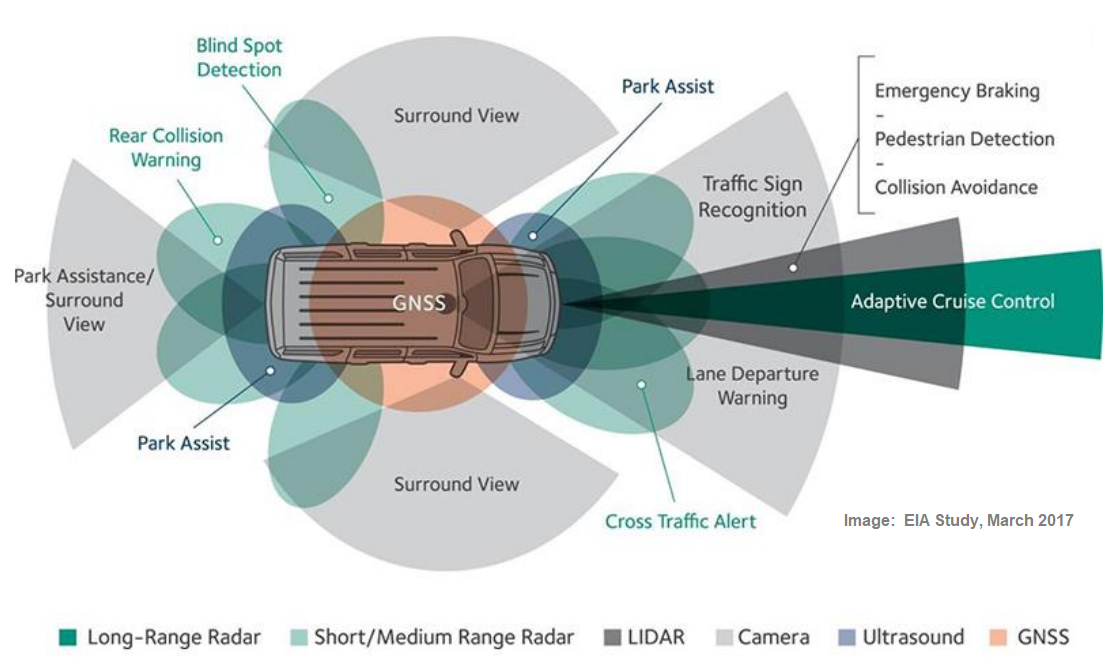Active Safety System Names Differ By Manufacturer
September 24, 2018
Active safety features are quickly propagating across the automotive world, with advanced driver assistance available on everything from compact economy cars to tech-forward luxury flagships.
But as more and more of these systems hit the market, the alphabet soup of acronyms and confusing nomenclature can make it difficult to determine what these systems actually do.
To help you out, below is a list of the active safety features that may come on your next car. Because different manufacturers tend to call them different things, we have included alternate names for every system.
Forward Collision Warning (FCW)
Also called: Pre-Collision System, Pre-Crash Warning System
Forward Collision Warning (FCW) is one of the simplest active driver aids on the market, providing alerts when an impending collision is detected. These systems warn the driver, but do not directly take action to mitigate a crash. The method of warning varies between models and manufacturers, but most provide some combination of audio cues, bright warnings in the gauge cluster, visual cues on a heads-up display, or a vibration in the seat or wheel.
Autonomous Emergency Braking (AEB)
Also Called: Collision Avoidance System, Collision Mitigation Braking System, Pre-Collision System with Auto Brake
Autonomous Emergency Braking (AEB) systems combine driver warnings with automatic braking intervention. When the vehicle detects an imminent collision, a warning is issued to the driver. Should the driver fail to respond quickly, the vehicle automatically applies the brakes to mitigate or avoid the collision.
All AEB systems can detect other cars on the road, but not all are equipped to respond to a pedestrian in the vehicle’s path. Systems with this capability are typically called AEB — or one of the alternative names — “with pedestrian detection.”
Adaptive Cruise Control (ACC)
Also Called: Active Cruise Control, Radar-Guided Cruise Control, Dynamic Radar Cruise Control, Traffic-Aware Cruise Control, Intelligent Cruise Control
Adaptive Cruise Control (ACC) uses the vehicle’s forward-looking radar or cameras to detect slower-moving traffic and automatically adjust your speed accordingly. The driver sets a maximum speed and the vehicle maintains it, like with a typical cruise control system, but with the added ability to automatically slow down when another vehicle is in the way.
Understanding the restrictions of these systems is vital, as ACC systems cannot adequately respond to stopped traffic from high speeds. Furthermore, while some are offered with “stop and go” functionality, others will automatically disengage below a certain speed, abruptly releasing the brake and requiring driver input for slow-moving traffic.
Lane Departure Warning (LDW)
Also Called: Lane Monitoring System
Lane Departure Warning uses the vehicle’s on-board cameras to watch lane markings above certain speeds. Should the vehicle depart its lane without activating the turn signal, an audio warning, visual cue, or vibration will be activated to alert the driver. Some systems use vibration motors in the steering wheel to simulate the feeling of the vehicle crossing a rumble strip on the highway, in order to provoke corrective action by the driver.
Lane Keep Assist (LKA)
Also Called: Lane Keeping Assist, Steering Assist, Lane Centering Assist
Lane Keep Assist (LKA) is to Lane Departure Warning as Autonomous Emergency Braking is to Forward Collision Warning. While Lane Departure Warning systems will alert you to an unintentional lane drift, LKA will take direct action to mitigate or avoid unintentional lane departure.
While some LKA systems only apply steering when you are at risk of crossing a lane marking, many manufacturers offer systems with lane-centering capability. This means that the system actively holds you in the center of the lane, requiring less steering input from the driver.
As with Adaptive Cruise Control, it’s important to understand the limitations of LKA systems. They rely on cameras to detect lane markings, meaning obscured or faded markings will cause the systems to disengage or behave unpredictably. These systems also cannot handle severe curves or construction zones. Driver attention and vigilance is always required.
Hogan, Mack. (2018). “This is what your new car’s active safety systems do to prevent crashes”. Retrieved from https://www.cnbc.com/2018/09/22/car-active-safety-systems-explained.html.
